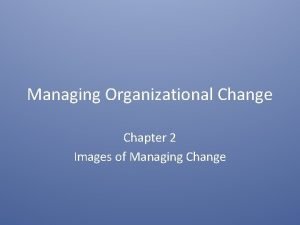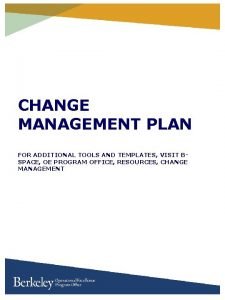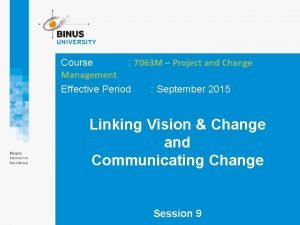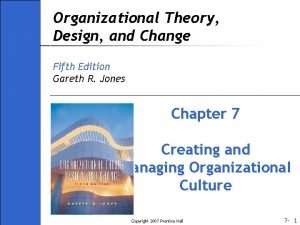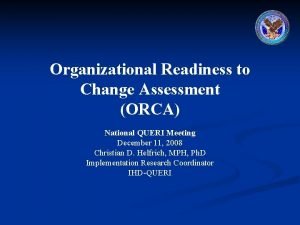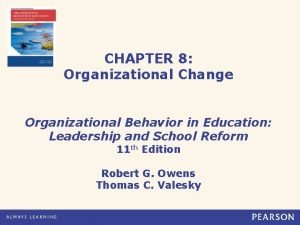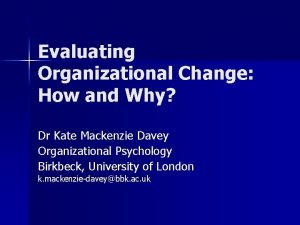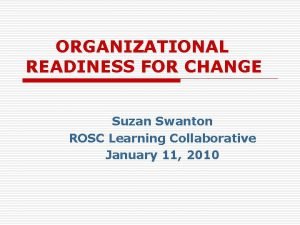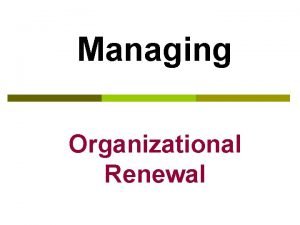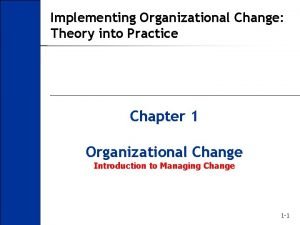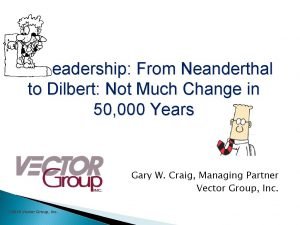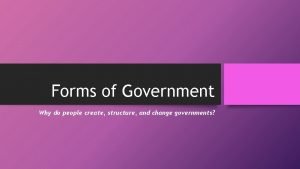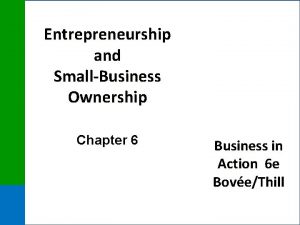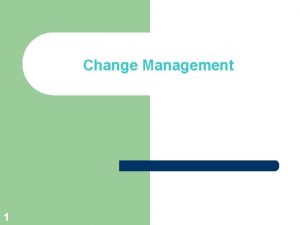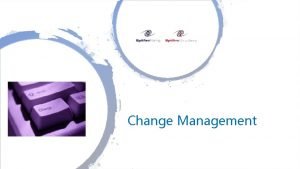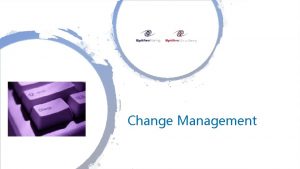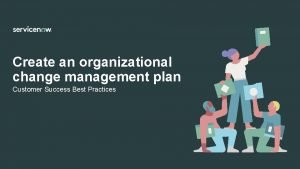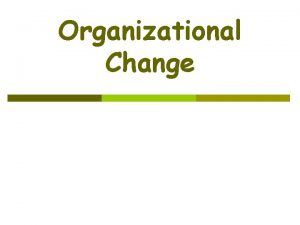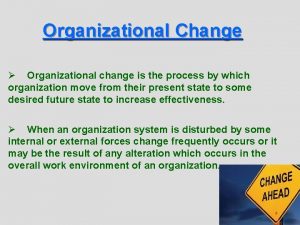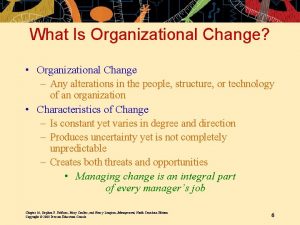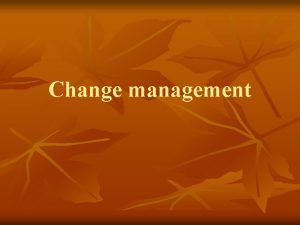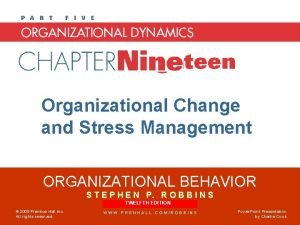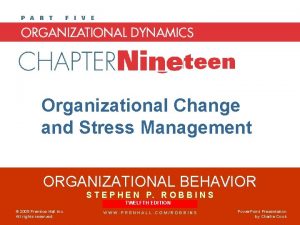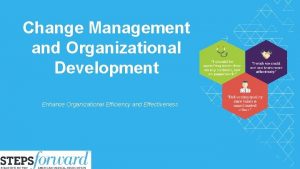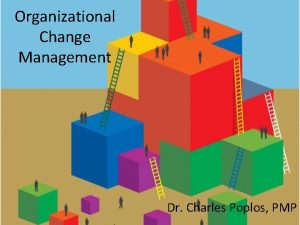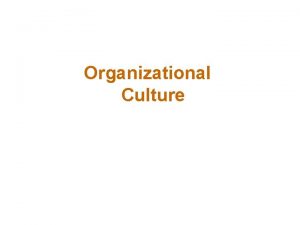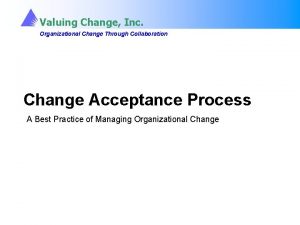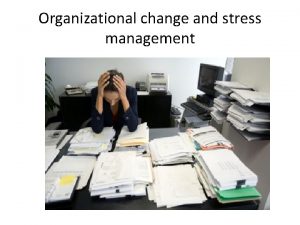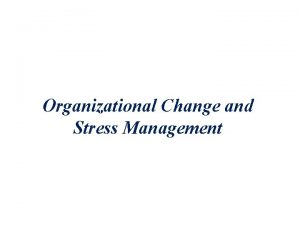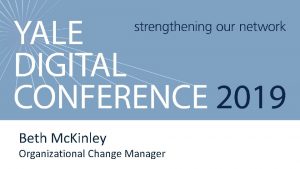Create an organizational change management plan Create an



























- Slides: 27

Create an organizational change management plan

Create an organizational change management plan Organizational change management (OCM) is the set of practices conducted before, during, and after projects that are used to identify and manage the challenges, pain points, and risks associated with making changes in how your organization functions or is organized. When done right, OCM activities engage the stakeholders who will be impacted by an organizational change, makes them aware of the changes, helps them understand the goals of the change, and influences them toward supporting, becoming involved in, and committing to the organizational change. Address OCM both during initial implementation and when expanding the capabilities that you manage on the Now Platform®, because stakeholder resistance can pose a serious risk to successful deployment and adoption. Organizations that apply OCM practices find that they reduce stakeholders’ concerns and experience greater support for their transformation vision. Insight: Creating an OCM plan Successful OCM efforts focus on involving and empathizing with the stakeholders impacted by organizational change to design approaches that offset as much stress and unpredictability before, during, and after implementation as possible. With this goal in mind, we recommend an OCM model that accomplishes the following goals before formally kicking off any deployment project: • Dedicates a role(s) to designing and managing an OCM plan that considers all stakeholders and contexts • Researches organizational context (including the stakeholders, risks, etc. ) to inform OCM planning • Uses collected knowledge of the organizational change environment to design an OCM plan that includes plans for how to communicate the organizational change with stakeholders, deliver needed training and enablement, and minimize the impact of organizational change After you’ve successfully managed the organizational change involved in your first Service. Now® deployment, consider how to improve your OCM practices over time to make it easier to manage organizational changes when you modify or expand how you use Service. Now in the future. Key implementation steps Start (complete before starting deployment, as possible) 1. Prepare to manage organizational change 2. Research organizational change context Improve 3. Document organizational change plans 2 4. Execute the organizational change Optimize 5. Build an OCM function © 2020 Service. Now, Inc. All Rights Reserved.

Step 1 a: Assemble your OCM program team Establishing a team to lead and manage your OCM program is an essential first step. Assign responsibilities (especially those owned by the OCM program lead) to roles that can fully dedicate to managing the organizational change affected by your implementation, to create opportunities for planning, communicating, and involving necessary stakeholders in the change process. Do this two to three months before the first Service. Now project kickoff to allow time for the team to complete OCM planning in time for kickoff. Assign an OCM program lead who is accountable and responsible for all OCM activities related to deploying Service. Now q Assign an OCM program lead. Consider the following options to fill this role: q Define the OCM program lead’s responsibilities, including: q Understanding the Now Platform and how it supports the organization's vision, mission, strategy, and business outcomes q Driving the coordination of meetings, communications and escalations with the steering committee, program management, implementation, training, and vendor teams q A Service. Now governance steering board member q Supporting and building the credibility of the OCM function within the organization q Someone from the office of the CIO with OCM experience q Leading OCM readiness assessments and assessment results analysis q Someone from marketing with communications experience q Developing and performing a stakeholder analysis with the executive sponsor and the OCM program team q An outside consultant who specializes in OCM q Reviewing and approving the OCM communication plan q Performing continuous OCM gap analysis (future state and current state) and risk analysis Practitioner insight: OCM is a part of good governance and should be developed concurrently with any changes in work processes and policy. To ensure consistency, your OCM program team and plan should be in alignment with, or a part of, your governance program. Steps 1. Prepare to manage organizational change q Developing the high-level organizational change enablement plan q Planning and administrating the appropriate program resources: people and technology such as websites, learning management systems, and communication tools, which include video, direct mail drops, focus groups, and surveys 2. Research organizational change context 3. Document organizational change plans 3 4. Execute the organizational change 5. Build an OCM function © 2020 Service. Now, Inc. All Rights Reserved.

Step 1 a: Assemble your OCM program team (Continued) Assemble an OCM program team with four key roles*, including: q A Service. Now OCM technical liaison lead role who works with the technical implementation team to coordinate the technical elements and the peopleoriented OCM elements of the Service. Now deployment/project** q A Service. Now OCM communication lead role who works with the OCM program lead to actualize the successful delivery of communications during the Service. Now program** q A Service. Now OCM enablement lead role who works with the OCM program lead to develop and deliver on the enablement plan for the Service. Now program** q A Service. Now OCM champion lead role who works with the OCM program lead to develop and deliver on the champion plan for the Service. Now program** Practitioner insight: The resources needed on your OCM program team depends on the size of your company and/or the extent of organizational change required by implementing or expanding Service. Now at your organization. You might have five or more people on the OCM program team (including a team lead and a dedicated person to manage each of the four Service. Now OCM roles defined in step 1 a), or you might just need a single person fulfilling all OCM responsibilities. Either way, the best practice is to fully dedicate roles to your OCM program. Temporary assignments are less likely to dedicate enough focus to this important role and will not help you build an effective OCM function over time. * Depending on your available resources and the scale of your change needs, you can dedicate a single person to each of these roles (either by hiring for the role or recruiting internally), or a smaller team or the single, dedicated OCM program lead can manage the responsibilities across these roles. If you dedicate a single person to each role, it will likely be a part-time role. ** Full job descriptions for each defined OCM responsibility/role are available in Appendix A. Steps 1. Prepare to manage organizational change 2. Research organizational 1. Prepare to manage 3. Document organizational Steps organizational change context organizational change plans change context 4 3. Document 4. Execute the 5. Build an OCM organizational change function change plans change function © 2020 Service. Now, Inc. All Rights Reserved.

Step 1 b: Prepare to launch the OCM program Before jumping directly into OCM planning, take the opportunity to make sure that your OCM program team members are all on the same page. It’s important that everyone involved in leading the OCM effort is aware of all context around the change, understands why OCM is necessary, and agrees on what needs to be achieved for their OCM process to be successful. Set goals for your OCM efforts—establish what “good” OCM looks like q Conduct a meeting with the OCM program team to define their OCM plan objectives q Discuss what “good” OCM looks like (e. g. , “helping our people feel comfortable with the Service. Now implementation through building stakeholder involvement by generating awareness, understanding, felt-need, buy-in, commitment, and action”) Have the OCM program team explore the organizational context that may affect your Service. Now deployment, and resulting OCM needs (sometimes called an “environmental scan”) q Work with your OCM program team to brainstorm and document elements about your organizational context that they think may affect your deployment (e. g. , recent team reorganizations, upcoming mergers and/or acquisitions, etc. ) q Have members from your OCM program team interview stakeholders (e. g. , team leads and one or two of their team members in departments that the deployment is impacting) to learn more about the organizational context. Ask interviewers to: q Share the elements they documented as a team with the stakeholders they interview and see if they agree and/or have ideas to add q Take notes about what they learn during these interviews Practitioner insight: Researching organizational context is especially important if you’re working with external consultants to lead your OCM program because it provides an opportunity for them to participate and learn about your environment. Steps 1. Prepare to manage organizational change q Schedule a meeting where the OCM program team members who conducted interviews can share their findings with the rest of the team. q Determine whether the team needs to reconsider any of their OCM goals (step 1 b) based on what they learned during these interviews. If changes need to be made, what needs to change? Why? Does the team need to set any new goals? q Discuss how your early exploration of the organizational context should guide future OCM planning (e. g. , very sensitive areas that deserve additional attention). 2. Research organizational 1. Prepare to manage 3. Document organizational Steps organizational change context organizational change plans change context 5 3. Document 4. Execute the 5. Build an OCM organizational change function change plans change function © 2020 Service. Now, Inc. All Rights Reserved.

Step 2 a: Conduct a stakeholder analysis A stakeholder analysis is a rigorous process to identify who will be affected by a change, how they will be impacted, what they will need in order to effectively transition, and how you should communicate with them. It’s critical that you do this early in your change process (if not first) so that you know who to consider when you build the rest of the change strategy for your implementation. Schedule a workshop with your OCM program lead and team to list every stakeholder who will be involved or impacted by the implementation q Start by listing the groups and teams that will be involved or impacted. Work with the OCM program lead and team to collect information and assess the impact of the change on each identified stakeholder q Document the following information for all stakeholders on your list: q The stakeholders’ name, title, role, function, reporting relationship q Then list the individuals in each group and team. q Their formal power (both the title and authority to affect the outcome of the Service. Now deployment/project and its success) and influence (the influence to affect the outcome of the Service. Now deployment/project through their networks and relationships)* q Consider if there any people who will be impacted that are not in a group or team that you listed. q How the change could impact the stakeholder and by how much q How often the stakeholder should be informed of progress and developments across the change process q Any new training the stakeholder might need Practitioner insight: The OCM program team should update the stakeholder analysis every two weeks. Some organizations grow or change so rapidly that key players may not be identified, and failure to communicate with them creates political issues. Steps 1. Prepare to manage organizational change q Organize the stakeholder information you collected into groups based on how they will be affected—this allows you to develop targeted OCM plans and efforts for specific groups. * This information is highly political and should never be posted on any project management site or knowledge base or sent to a large email distribution, etc. 2. Research organizational 1. Prepare to manage 3. Document organizational Steps organizational change context organizational change plans change context 6 3. Document 4. Execute the 5. Build an OCM organizational change function change plans change function © 2020 Service. Now, Inc. All Rights Reserved.

Step 2 b: Conduct an OCM readiness assessment A readiness assessment is an early step that the OCM program team needs to take as part of determining how ready the organization is for the planned implementation. This assessment can reveal early indicators of the support, control issues, resource concerns, and resistance likely to surface before, during, and after implementation. Lack of readiness can often lead to failed or stalled implementations. Score assessment responses and work with your OCM program lead to review results Ask a consistent set of questions and “what if” scenarios to each of your identified stakeholders to assess how ready they are for the planned change and to surface potential concerns (this can be done in interviews, via survey, and/or as a series of focus group meetings or workshops)* q Collect all responses to your set of questions. q Make sure you get a good workshop participation and/or survey response rate (at least 50%). q Coordinate assessments with the interviews the implementation team is scheduling for requirements gathering and process analysis. Note: They could happen at the same time. q Assign the OCM program lead to review and summarize the results. ** q Assign the OCM technical liaison lead (dedicated in step 1 a) to share assessment results and summary with the team responsible for managing the implementation—do this live, never via email. Practitioner insight: Readiness assessments can (and should) be done throughout any new deployment processes (e. g. , at the start, after requirements are complete, after training, after a pilot, etc. ). Track if overall OCM readiness scores don’t change when you repeat the assessment and especially if they get worse—this might mean that you need to investigate how well your ongoing OCM strategies are working. q Share assessment results with all participating stakeholders to ensure transparency and build trust. q Use this presentation as an opportunity to explain what good organizational change looks like, comparing current assessment results with the ideal to set goals for ongoing change management strategies. * See Appendix B for additional guidance on developing OCM readiness assessment questions. q Record any feedback or suggestions you get from stakeholders. ** See Appendix C for additional guidance on how to review OCM readiness assessment results. Steps 1. Prepare to manage organizational change 2. Research organizational 1. Prepare to manage 3. Document organizational Steps organizational change context organizational change plans change context 7 3. Document 4. Execute the 5. Build an OCM organizational change function change plans change function © 2020 Service. Now, Inc. All Rights Reserved.

Step 2 c: Conduct an OCM impact analysis The OCM impact analysis is used to determine global, group (function or work team), and individual impacts as a result of the change. It looks at all Service. Now project work streams to identify issues that might lead to resistance and plans appropriate change actions to proactively resolve these issues (strategy, training, communication, new resources, etc. ). Since an impact analysis is highly context dependent, you must complete the OCM readiness assessment and the stakeholder analysis before the OCM impact analysis. Work with the OCM program lead and team to analyze what types of impacts will result from the change and the degree of each impact Identify possible changes in processes and requirements q Assign the OCM technical liaison lead (dedicated in step 1 a) to identify operational changes, issues, and challenges that could occur during the change. q Document your responses to the following questions (and any others as needed): q Where will the organizational change most directly impact specific stakeholders? q Work with process owners and operations teams to identify where operational changes, issues, and challenges might occur (e. g. , disruptions to current operational process flows) due to changes during the transition. q Are the stakeholders who are impacted the most considered supportive, resistant, or neutral about the organizational change? q Are there any major risks of issues that will result from this organizational change? For example, could it jeopardize business goals not directly related to the Service. Now deployment, etc. ? q Identify business process gaps that could disrupt business activities during the transition (e. g. , changes that result in temporary downtime for services commonly used by the business). q Will any jobs change, requiring hiring, retraining, relocations, etc. ? q Are any new jobs being created? Use what you learned in the OCM impact analysis to inform and/or update project objectives within the overall OCM plan q Will people on the current team stop being “experts” because their areas of competence are being eliminated? q Document what you learned as part of the change impact analysis so you can include these insights into the OCM plan (which you will pull together in step 3). q Categorize the impacts by stakeholder groups (defined in the stakeholder analysis, step 2 a), noting where identified impacts are most commonly shared within a group. Steps 1. Prepare to manage organizational change 2. Research organizational 1. Prepare to manage 3. Document organizational Steps organizational change context organizational change plans change context 8 3. Document 4. Execute the 5. Build an OCM organizational change function change plans change function © 2020 Service. Now, Inc. All Rights Reserved.

Step 2 d: Conduct OCM risk assessment While some risks are identified as part of the OCM impact analysis, an OCM risk assessment is your opportunity to dive deeper and evaluate all the impacts of your implementation and the potential risks they pose. Surfacing these risks early leads to better decision-making when you schedule and plan committed resources. This is the last step in researching organizational change context, and it builds on what you learned in earlier steps. Work with your OCM program team to list potential risks q Review the other discovery elements of the OCM plan, including the environmental scan, OCM readiness assessment, stakeholder analysis, and OCM change impacts q List the risks (factors that could affect the successful outcome of your Service. Now deployment) that you anticipate as part of the change, your proposed solution for mitigating each risk, and the action items you need to take to mitigate the risk. Conduct a whiteboarding exercise, led by your OCM program lead and team, with a group of stakeholders that broadly represents your stakeholder audience (defined in step 2 a): q Ask all participants a set of questions (one question at a time), including: q What do you consider the biggest risk for this project? q Will there be a change to the organizational structure? q How many people will be impacted (i. e. , experience a change in how they work)? q Gather answers and post them as a list on a whiteboard/easel (noting duplicate responses) —this helps you get a sense of whether everyone is already on the same page or whether their answers differ. q Finish the workshop by setting some next steps, including: Practitioner insight: Consider using “what if” scenarios to source ideas from the group to help them think about all of the possibilities, not just the safe probabilities. This should help you collect a more expansive list of ideas. Steps 1. Prepare to manage organizational change q Assigning action items for each attendee that inform how they can help mitigate a specific risk (based on their roles/responsibilities) q Setting up an ongoing schedule of check-ins (at least every other week during OCM planning and execution) with attendees to review how risks have been mitigated, to discuss any new risks that have been uncovered, and to source ideas for new risk mitigation 2. Research organizational 1. Prepare to manage 3. Document organizational Steps organizational change context organizational change plans change context 9 3. Document 4. Execute the 5. Build an OCM organizational change function change plans change function © 2020 Service. Now, Inc. All Rights Reserved.

Step 3 a: Design a future-state organizational design Service. Now implementation can often result in the need to reconsider your current organizational design, especially if you’re deploying multiple solutions on the platform. Engage HR early to consider how the design of your organizational model, groups structure, roles, and jobs might need to change as part of the deployment/project. Connect your OCM program team with a partner from your organization’s HR group to: q Share your OCM context research (stakeholder analysis, readiness assessment, impact analysis, etc. from step 2) with your HR partner. q Discuss any anticipated changes to the organization’s group structure, headcount, and role and job descriptions with your HR partner. q Decide if there will be any changes to the organizational hierarchy, in terms of reporting lines and how information flows from executives to teams. Practitioner insight: Organization design planning and rollout can visualize the change and give clear indications of where people changes and mitigations need to take place. It also forms the basis of timely communication to educate on how the change effects the organization and the individual. q Decide if any changes need to be made to the incentive system to influence the balance between individual control and the need to align work toward the goal of ensuring a successful implementation. q Consider adding OCM-related questions to your employee satisfaction surveys, if possible. q Consider adding OCM-related components to relevant employee performance reviews, if possible. q Define any changes that need to happen to the operating model that governs how work flows across and within different groups. q Design how new Service. Now groups will fit in a new organizational structure (e. g. , a Service. Now platform support team). Steps 1. Prepare to manage organizational change 3. Document 2. Research organizational 1. Prepare to manage Steps organizational change context organizational change plans change context 10 3. Document 4. Execute the 5. Build an OCM organizational change function change plans change function © 2020 Service. Now, Inc. All Rights Reserved.

Step 3 b: Plan OCM training and enablement Enabling planning is your opportunity to empower stakeholders by helping them realize what’s in it for me (WIIFM)—essentially new skills. Technical training, for example, is a key related element of OCM training. For Service. Now implementation, all specific training by role (e. g. , fulfiller training, system administrator training, or developer training) needs to be incorporated into the overall enablement plan and schedule. Assign the OCM enablement lead (dedicated in step 1 a) to define which additional trainings might be needed by impacted stakeholders due specifically to organizational change q Review the list of impacted stakeholders assembled in the OCM impact analysis (step 2 c). q Organize the stakeholders into groups based on the types of work they do. q Define how you think each stakeholder groups’ work will change and what new skills they might need (e. g. , experience with a new process, application, or tool). q Design a training and enablement curriculum that will help each group develop the skills they need (consider where Service. Now courses can provide needed training), considering: q How much training is needed to build the new skills? q Who will be responsible for organizing and/or delivering the training? q How will you actually deliver the training? q Who needs to approve that training is complete? q Plan deadlines for when training should be completed before deployment starts. For example, the core Service. Now platform support team and Service. Now administrators should be trained before deployment starts and fulfiller training should be completed two to three months before golive. Steps 1. Prepare to manage organizational change 3. Document 2. Research organizational 1. Prepare to manage Steps organizational change context organizational change plans change context 11 3. Document 4. Execute the 5. Build an OCM organizational change function change plans change function © 2020 Service. Now, Inc. All Rights Reserved.

Step 3 c: Develop your communication plan Effective communication is a critical tool that you need to use to lead your stakeholders from simply being aware of your implementation and the changes that result to actually supporting and committing to the change. To do this well, you need to plan ahead for what you need to communicate, which stakeholders need to know, and when they need to know it. Assign the OCM program lead and OCM communication lead (dedicated in step 1 a) to develop an OCM communication plan that considers: q Audiences – What audiences, stakeholders, and/or stakeholder groups do you need to communicate with? What do you need to communicate to each audience? q Messages – How will you deliver targeted, timely, and consistent information while showing continuity from one communication to the next? Plan messaging to communicate important changes and how you plan to mitigate the impact of these changes, including: q Changes to organizational design (organizational structure, teams, operating model, roles) q Changes to existing processes and workflows q Changes in the technologies each stakeholder uses (what will be added, removed, changed, etc. ) q Training needs q Tools and activities – Plan to deliver your messages (i. e. , email, web meeting, etc. ) based on what your target audience is more likely to pay attention to. q Resources and schedules – How will you set appropriate expectations on what information you are going to deliver and when? Note: It’s always a good idea to under promise and over deliver on this. q Evaluation – How do you plan to evaluate the effectiveness of your messages? Note: Service. Now champions can provide excellent feedback on how well your communications are being received. Steps 1. Prepare to manage organizational change 3. Document 2. Research organizational 1. Prepare to manage Steps organizational change context organizational change plans change context 12 3. Document 4. Execute the 5. Build an OCM organizational change function change plans change function © 2020 Service. Now, Inc. All Rights Reserved.

Step 3 d: Assemble your OCM plan OCM is a major component in any Service. Now deployment/project and is tightly integrated with the overall technical plan and roadmap. So it’s important that you incorporate your OCM research and plans in the overall Service. Now program plan. The best way is to compile your findings into one easily shareable document that includes an executive summary of all of the plan elements you developed earlier (stakeholder analysis, impact analysis, risk assessment, etc. ) and their associated tasks/activities. Ideally, the OCM plan should be assembled before you kick off deployment—although you can make modifications and additions after that. Work with the OCM program team to combine all documented OCM research and plans into one overall OCM plan q Collect all documented research and plans from all members of the OCM program team. q Ask the OCM program team members to note where there is sensitive information in their documents, so you can decide whether or not to include it in your overall plan. q Get each OCM program team member to provide a brief summary of each document that can be used as an abstract for that section of the overall plan. q Combine all collected documents in one comprehensive document. q Write an executive summary that provides an overview of all major findings and plan components and lists the other documents included in the overall plan. q Include recommendations for where the impacts of the organizational change can be minimized based on your research. Steps 1. Prepare to manage organizational change 3. Document 2. Research organizational 1. Prepare to manage Steps organizational change context organizational change plans change context 13 3. Document 4. Execute the 5. Build an OCM organizational change function change plans change function © 2020 Service. Now, Inc. All Rights Reserved.

Step 4 a: Use your OCM plan Good OCM planning effectively engages your stakeholders throughout the process (during workshops, surveys, etc. ), which helps them feel more comfortable with the change over time (because they can feel like they are part of the change). That means that you should be close to achieving your OCM goals (e. g. , “helping our people feel comfortable with the Service. Now implementation through building stakeholder involvement by generating awareness, understanding, felt-need, buy-in, commitment, and action”) by the time you’ve assembled your OCM plan. At this stage, it’s time to put the final touches on your OCM planning—particularly on your OCM communication plans—into action in advance of your Service. Now pilot and go-live. Share your OCM plan q Share the executive summary for your OCM plan (created in step 3 d) with all stakeholders identified in your OCM stakeholder analysis (step 2 a). q Make sure to remove any sensitive information (especially stakeholder information) from the summary that you share. Act on your communication plan ahead of the Service. Now pilot and go-live to make sure your stakeholders are well informed and as comfortable with the upcoming changes as possible q Enact your OCM communication plan (of you haven’t already) to share information with stakeholders (identified in Step 2 a). q Make sure that communications start at least six to eight weeks before your pilot. q Vet your recommendations for how to minimize the impacts of the organizational change (defined in your OCM plan in step 3 d) with your Service. Now executive sponsor and senior leaders that your executive sponsor thinks should be consulted. q Work with the OCM program team to make sure that your recommendations are executed. Steps 1. Prepare to manage organizational change 2. Research organizational 1. Prepare to manage 3. Document organizational Steps organizational change context organizational change plans change context 14 3. Document 4. Execute the 5. Build an OCM organizational change function change plans change function © 2020 Service. Now, Inc. All Rights Reserved.

Step 4 b: Plan pilots and go live The pilot is a dry run of the entire Service. Now solution before go-live and is an essential opportunity to find out both how well the solution works and how prepared your stakeholders are for the incoming change. Invest in designing a comprehensive pilot and remember to take notes during the pilot so you can identify if anything else needs to happen (e. g. , additional training, enablement, communication, etc. ) before and shortly after your go-live date. Plan pilots* (scripted simulations to test all processes and handoffs involved in the Service. Now solution being implemented) using a subset of the stakeholders q List all of the stakeholders who need to participate in the pilots (this usually includes most stakeholders). q Work with the implementation team to script how you plan to involve all stakeholders (including those who are less familiar with Service. Now) in the pilot so that each stakeholder group is involved in testing the applications and tools they will be working with when the solution goes live (this is called a pilot story). q Script the most complicated scenario you can think of to include and test all components and functionalities of the solution you’re deploying. q Deliver the pilot story to all pilot participants at least five working days before the start of the pilot so they can understand their access, role, handoffs to other stakeholders, and the expected outcome of the pilot (i. e. , what constitutes “success”). q Work with the system administrator for Service. Now to enable access to requested applications and tools for involved stakeholders q Test that this access is working at least 3 days before the start of the pilot q Schedule the pilot so that it takes place at least 3 weeks before go-live so corrections to the process can take place q Collect lessons learned from the pilot q Use what you find out during pilots to add to your frequently asked questions (FAQs) list to support similar issues post go-live q Document known issues that you uncover during the pilot so that you can craft workarounds in time for go-live and so you can fix those issues later on q Consider if any additional OCM activities (e. g. training, enablement, communication, etc. ) are needed before go-live based on how well the pilot went Steps 1. Prepare to manage organizational change 2. Research organizational 1. Prepare to manage 3. Document organizational Steps organizational change context organizational change plans change context 15 3. Document 4. Execute the 5. Build an OCM organizational change function change plans change function © 2020 Service. Now, Inc. All Rights Reserved.

Step 4 b: Plan pilots and go live (Continued) Capture a success story that advertises what you accomplished in your Service. Now deployment to drive awareness Plan your Go-live communication and celebration q Make sure that you spread news that your solution is live (via intranets, workplace social networks, email, etc. ) q Interview stakeholders to record their experience throughout the deployment process and since going live on Service. Now, asking: q Plan a go-live party to celebrate your successful implementation q Which issues were resolved through this deployment on Service. Now? q Ensure that everyone is invited (within reason, but especially including all OCM stakeholders identified in OCM stakeholder analysis – step 2 a) q What value did the Service. Now deployment deliver? q Can you provide any data/statistics that help prove the value of Service. Now? (e. g. number of incidents logged via self-service”) q Have a theme and create flyers and posters about what was accomplished to hang/pass out during the celebration q Have the Service. Now executive sponsor attend address the audience with goals, accomplishments, and information on what’s next q Recognize people who were early users during the go-live celebration (e. g. first person to close a case, 100 th person to request something, etc. ) q Use what you learn to create content (e. g. case studies, monthly newsletter blogs, posters, presentations for employee webinars, etc. ) that you can share to drive awareness about your successful Service. Now deployment Practitioner insight: Go-live is a major milestone – don’t forget to celebrate it, especially because a go-live party can really help get/keep your stakeholders excited about Service. Now usually supplies customers with a custom cake to celebrate their deployment. Steps 1. Prepare to manage organizational change 2. Research organizational 1. Prepare to manage 3. Document organizational Steps organizational change context organizational change plans change context 16 3. Document 4. Execute the 5. Build an OCM organizational change function change plans change function © 2020 Service. Now, Inc. All Rights Reserved.

Step 5: Build an OCM function Service. Now customers realize the strategic value of the Now Platform and aspire to upgrade twice each year. This aspiration will drive continuous change and OCM capabilities will need to grow with the Service. Now program. Use evaluations as a way to determine how effective the overall OCM program is and identify where improvements are needed in the future q Assign the OCM program lead and communication lead to work with HR to design and distribute stakeholder satisfaction surveys every three months to different types of stakeholders across the company, including questions that: q Ask if they’ve heard about the Service. Now deployment Practitioner insight: Evaluation is a key tool for understanding adoption and stakeholder commitment. In addition to learning from the information shared by stakeholders during your evaluation, take note of the overall customer satisfaction survey response rate and of the stakeholders who respond. This provides useful information for ongoing stakeholder analysis. q Ask if they’ve used it and how well it is working for them q Ask how they would like to receive information about future changes (e. g. , email, social networks, word of mouth, etc. ) q Ask for any optional feedback q Assign the OCM program lead to assemble an OCM evaluation plan document, that includes: q Plans for ongoing evaluation, including periodic stakeholder satisfaction surveys q Sample stakeholder satisfaction surveys/survey questions q Plans for how to use what you learn from ongoing evaluations to identify where your OCM program needs to be improved Steps 1. Prepare to manage organizational change 2. Research organizational 1. Prepare to manage 3. Document organizational Steps organizational change context organizational change plans change context 17 3. Document 4. Execute the 5. Build an OCM organizational change function change plans change function © 2020 Service. Now, Inc. All Rights Reserved.

Step 5: Build an OCM function (Continued) Maintain your OCM program team and update OCM documents (including the overall OCM plan) over time q Schedule an OCM program team meeting every three months when the team is not actively involved in OCM planning for a specific deployment/project. q Discuss where OCM analysis and planning documents (including the overall OCM plan) need to be refreshed and make edits accordingly. q Plan ahead for upcoming or anticipated OCM needs. q Consider developing some sort of OCM portal or resource center where users can access OCM plans and supporting materials. This can be a subset of articles in your knowledge management system. Practitioner insight: The most important insight here is that you should not dissolve the team that manages OCM after completing any specific project. Keep the OCM program team alive when there aren’t active projects, even if it’s just a parttime activity for the roles on the team. There will always be OCM needs (e. g. , every time a new feature or function releases, during upgrades, when you adopt new solutions on the Now Platform, etc. ), so it’s important that you preserve your OCM program to help navigate all future Service. Nowrelated organizational change. q Work with the OCM champion lead (defined in Step 1 a) to expand your community of champions to support future OCM efforts. Steps 1. Prepare to manage organizational change 2. Research organizational 1. Prepare to manage 3. Document organizational Steps organizational change context organizational change plans change context 18 3. Document 4. Execute the 5. Build an OCM organizational change function change plans change function © 2020 Service. Now, Inc. All Rights Reserved.

KPIs and stakeholders Key performance indicators Essential KPIs Nice-to-have KPIs • • Stakeholder map % of defined OCM program team roles filled % of identified training needs fulfilled # of unique users migrated to Now Platform (post go-live) Average # of daily users (post go-live) % of stakeholders actively committing to the organizational change # of Service. Now champions • # stakeholders identified in stakeholder analysis % response rate for OCM readiness assessment survey % response rate for OCM evaluation surveys Responsible/accountable Consulted/informed • • • Now Platform owner Service. Now governance team lead Service. Now OCM program team 19 CIO Business leadership Service owners Service. Now governance committees Business stakeholders (informed only) Vendor representatives (informed only) Business engagement teams Partners © 2020 Service. Now, Inc. All Rights Reserved.

Appendix A: OCM role descriptions Title: Service. Now OCM program lead The Service. Now OCM program lead works with leader/executive sponsor to actualize the successful delivery of Service. Now solutions and services for our clients. This role is consultative, strategic, and tactical. This role is usually filled by an individual who is a member of the Service. Now governance steering committee. This individual is responsible for executing changes related to people and coordinating with other program and project management for changes related to process and technology. Responsibilities: The Service. Now OCM program lead is primarily responsible for managing the successful deployment of Service. Now by: • Understanding the Now Platform and how it supports the organization’s vision, mission, strategy, and business outcomes • Using the agreed upon operating model to drive the coordination of meetings, communications, and escalations with the steering committee, project/program management, implementation, training, and vendor teams • Supporting and building the credibility of the change management function within the organization in general and for the project • Establishing and benchmarking readiness across the organization • Developing and performing stakeholder analysis with the executive sponsor, the OCM communication lead(s), and the OCM enablement lead(s) to establish reporting relationships and networks; stakeholders’ relative power, influence, impact mitigation, and associated enablement needs; and audience types for the communication plan • Reviewing and approving the communication plan for the project • Performing continuous gap analysis (future state/current state) and risk analysis • Analyzing risk mitigation(s) for needed changes in resources—budget, time, enablement, and schedule—so they are aligned with process and technology changes • Developing the high-level enablement plan: principles of ITIL and service management processes, overview of Service. Now processes • Planning and administering the appropriate project/program organizational change resources, including the people and technology—websites, learning management systems, and communication tools such as video, direct mail drops, focus groups, and surveys—to support the project’s or program’s communication 20 © 2020 Service. Now, Inc. All Rights Reserved.

Appendix A: OCM role descriptions (Continued) Title: Service. Now OCM technical liaison lead The Service. Now technical liaison lead works with the OCM project lead to develop and support the technical framework for the Service. Now OCM project/program. This role is focused on coordinating with other functions and departments to use internal resources. This role can be filled by a member of the OCM team or by someone who is part of technical support for employee communications within the company. This individual is responsible for managing the OCM enablement program. Responsibilities: The Service. Now technical liaison lead is primarily responsible for supporting the successful deployment of the Service. Now champion plan/program internally by: Understanding the Now Platform and how it supports the organization's vision, mission, strategy and business outcomes Leading the technical support for all internal applications/tool sets/websites for the program: Collaboration between team members – MS teams, Share. Point, Slack, etc. Documentation – Service. Now Knowledge Base, other internal KB Communication – Emails, web meetings Enablement – Web-based training, frequently asked questions, training scheduling Working with the OCM communications lead on communications plan support Working with the OCM champion lead on champion program support Working with the OCM enablement lead on enablement support Planning, developing, managing, and delivering all program analytics to include readiness assessments, stakeholder enablement completion, and communication effectiveness 21 © 2020 Service. Now, Inc. All Rights Reserved.

Appendix A: OCM role descriptions (Continued) Title: Service. Now OCM communication lead The Service. Now OCM communication lead works with the OCM project lead to actualize the successful delivery of communications during the Service. Now project/program. This role is focused on communicating project vision, mission, strategy, and business outcomes using the communication plan. The communication plan focuses on why, what, how, and who to move stakeholders from awareness to commitment. This role is usually filled by a member of the OCM team. This individual is responsible for developing and coordinating delivery of all communications for the project using the communication plan. Responsibilities: The Service. Now OCM communication lead is primarily responsible for managing the successful deployment of the Service. Now communication plan internally by: Understanding the Now Platform and how it supports the organization's vision, mission, strategy, and business outcomes Developing the framework for communication, which outlines the structure and guiding principles that the communication team will operate within Developing a process for using stakeholder Identification and stratification to create project audiences Working with the OCM champion lead, establishing the champion team charter and communications Developing project messages and then the communication(s) and media used to deliver the message Developing the timetable/schedule of communication activities and delivering the activities in coordination with the other members of the OCM team (i. e. , executive sponsor, OCM lead, OCM champion lead, OCM technical liaison, and OCM enablement lead) to: Map target audience messaging to phases of the project (the what and the how): initiate phase or kickoff; examine phase for internal discovery and gap analysis; plan phase for planning of project and schedule; create phase for development and sprints; and transition or go live Maps target audience messaging to comprehension and acceptance of the project (‘the Why and Who”) (Phases: Awareness, Understanding, Support, Involvement, Commitment) Designing methods and tools for assessing communication effectiveness: Analyzes the assessments and shares them with the OCM team and executive sponsor Adjusts communications strategy and tactics to improve effectiveness Schedules evaluations throughout the program for continuous improvement 22 © 2020 Service. Now, Inc. All Rights Reserved.

Appendix A: OCM role descriptions (Continued) Title: Service. Now OCM enablement lead The Service. Now OCM enablement lead works with the OCM project lead to develop and deliver on the enablement plan for the Service. Now project/program. This role is focused on enabling/educating all stakeholders for the program (governing committee, project team members, system administrators, process fulfillers, approvers, and requesters (end users). This role is usually filled by a member of the OCM team. This individual is responsible for managing the OCM enablement program. Responsibilities: The Service. Now OCM enablement lead is primarily responsible for managing the successful deployment of the Service. Now champion plan/program internally by: • Understanding the Now Platform and how it supports the organization's vision, mission, strategy, and business outcomes • Developing the enablement team operating model, which outlines the structure and guiding principles the team will operate within • Developing enablement plans with the OCM project lead, the OCM communication lead(s) and the OCM enablement lead(s) that use the stakeholder analysis to: o Inform, educate, and enable all types of stakeholders (governing committee, project team members, system administrators, process fulfillers, approvers, and requesters (end users)) o Deliver targeted and timely training to provide mitigation for impacts to roles and responsibilities based on: 1) Total job change, 2) New hire or transfer, 3) Task responsibility, 4) Learning curve, 5) All of the above, 6) Other impact(s) • Coordinating with the OCM communication lead to incorporate enablement activities into the communication plan so as to: o Deliver the correct communication about enablement/training sessions in a timely manner o Assure scheduling and delivery resources are informed o Provide consistency and continuity across the project/program • Performing session evaluation immediately following the delivery of any informational or training curriculum to identify gaps, issues, and concerns • Adjust training curriculum content, delivery, or resources based on the analysis of evaluations • Plan and deliver a pilot program post training and pre go-live to determine the FAQs that need to be available for clarification and for use prior to the next scheduled release of Service. Now. 23 © 2020 Service. Now, Inc. All Rights Reserved.

Appendix A: OCM role descriptions (Continued) Title: Service. Now OCM champion lead The Service. Now OCM champion lead works with the OCM project lead to develop and deliver on the champion plan for the Service. Now project/program. This role is focused on creating and educating a team of champions/evangelists for the program who can help move stakeholders through the commitment lifecycle. The champion team provides timely and specific feedback to executive, project/program, and OCM leadership. This role is usually filled by a member of the OCM team. This individual is responsible for managing the champion program. Responsibilities: The Service. Now OCM champion lead is primarily responsible for managing the successful deployment of the Service. Now champion plan/program internally by: Understanding the Now Platform and how it supports the organization's vision, mission, strategy, and business outcomes Developing the champion team operating model, which outlines the structure and guiding principles the champion team will operate within Leading champion recruitment and coordinating with OCM team members for communication Based on the population of the team (expertise, location, function, etc. ), working with the OCM enablement lead to design specific and targeted project enablement for champions Teaming with the OCM communication lead and the OCM enablement lead to design and deliver the champion programs Developing agendas for and manages the weekly, monthly, and quarterly champion team meetings in conjunction with project/program/OCM leadership Reviewing weekly project reports and updating the champion team via weekly or bimonthly team meetings (frequency at the beginning of the project is recommended and can be reduced as a strong working cadence is in place) during which they: Solicit feedback from the champion team for designated work streams based on areas of expertise: enablement, development of systems, operating model, processes, capabilities, testing and QA, governance, or OCM Evaluate feedback to identify gaps, issues, and concerns Summarize feedback in the form of weekly reporting to the project/program/OCM leadership 24 © 2020 Service. Now, Inc. All Rights Reserved.

Appendix B: OCM readiness assessment questions When developing a set of OCM readiness assessment questions: q Include questions that assess if each stakeholder thinks they and the organization are ready for the change (individual readiness) , such as: q Do you think this organization is ready for change? Is this project a priority? q How do you feel about the change? Are you ready? What would it take to make you feel ready? q Include questions that test the stakeholders’ ability to work together and effectively manage the change, such as: q Do you trust your peers (in your work group) will be supportive of this effort? q Do your peers and team members have the necessary skill sets to support this project? q Include questions that assess the organizational context that the change will take place within , such as: q Are your current policies and processes flexible enough to accommodate the change? q Are the necessary approval workflows, systems, and logistics in place to accommodate the change? q Is the executive sponsor trusted and do they have influence in the organization? q Use multiple choice questions when possible to make it easier to score the results. q Use “what if” scenarios to collect responses if you have any focus groups of workshops as part of assessing organizational and stakeholder readiness, such as: q List of good reasons for not getting involved in the proposed project (no time, no motivation and/or inclination) q List of good reasons for getting involved in the proposed project 25 © 2020 Service. Now, Inc. All Rights Reserved.

Appendix C: OCM readiness assessment review When reviewing responses to the questions in your OCM readiness assessment, consider the following questions: q Were there any clear trends overall? q Did different types of stakeholders consistently answer any questions differently than others? q Are there any unexpected results, such as those regarding strong negative trends? q Does the assessment reveal any potential risks, like low confidence that the organization is ready for change, low trust between stakeholders, etc. ? q What needs to happen with future change management efforts based on what you learned from the change readiness assessment? 26 © 2020 Service. Now, Inc. All Rights Reserved.

Customer Success Best Practices Service. Now’s Best Practice Center of Excellence provides prescriptive, actionable advice to help you maximize the value of your Service. Now investment. Definitive guidance on a breadth of topics Created and vetted by experts Strategic Best practice insights from customers, partners, and Service. Now teams Critical processes Management Expert insights Distilled through a rigorous process to enhance your success Tactical Designed for: Platform owners and teams Practical Actionable Valueadded Expertvalidated Based on thousands of successful implementations across the globe Technical Common pitfalls and challenges Executive sponsors Proven to help you transform with confidence Service and process owners Get started today. Visit Customer Success Center. 27 Contact your Service. Now team for personalized assistance. © 2020 Service. Now, Inc. All Rights Reserved.
 Managing change and stress
Managing change and stress Six images of change management
Six images of change management Jika noel(create(q)) adalah 0 maka front(create(q)) adalah
Jika noel(create(q)) adalah 0 maka front(create(q)) adalah Change management heat map template
Change management heat map template Adkar assessment template
Adkar assessment template Change management plan binus
Change management plan binus Organizational change adalah
Organizational change adalah Development change adalah
Development change adalah Organizational theory design and change
Organizational theory design and change Orca assessment
Orca assessment Organizational change in education
Organizational change in education Implementing organizational change spector
Implementing organizational change spector Evaluating organizational transformation
Evaluating organizational transformation Organizational readiness for change maryland
Organizational readiness for change maryland Leading change and organizational renewal
Leading change and organizational renewal Leading change and organizational renewal
Leading change and organizational renewal Implementing organizational change theory into practice
Implementing organizational change theory into practice Dilbert change management
Dilbert change management What is organization
What is organization Why do people create, structure, and change government?
Why do people create, structure, and change government? Building owner chapter 6
Building owner chapter 6 Is mashing potatoes a physical or chemical change
Is mashing potatoes a physical or chemical change Physical changes vs chemical changes
Physical changes vs chemical changes Absolute change and relative change formula
Absolute change and relative change formula Integers meaning in maths
Integers meaning in maths Difference between a chemical and physical change
Difference between a chemical and physical change Change in supply vs change in quantity supplied
Change in supply vs change in quantity supplied Supply and demand curve shifts
Supply and demand curve shifts

